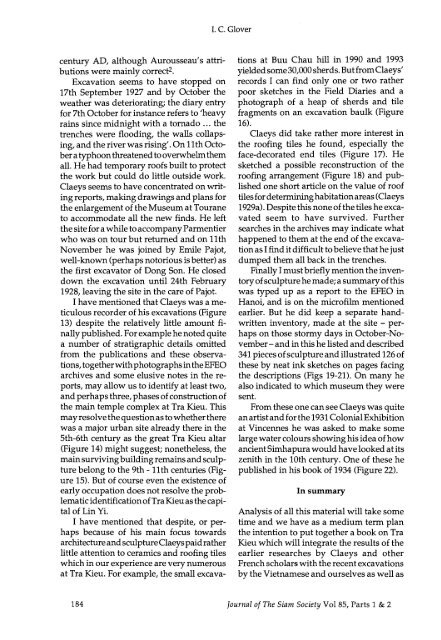The Journal of the Siam Society Vol. LXXXV, Part 1-2, 1997 - Khamkoo
The Journal of the Siam Society Vol. LXXXV, Part 1-2, 1997 - Khamkoo
The Journal of the Siam Society Vol. LXXXV, Part 1-2, 1997 - Khamkoo
You also want an ePaper? Increase the reach of your titles
YUMPU automatically turns print PDFs into web optimized ePapers that Google loves.
I. C. Glover<br />
century AD, although Aurousseau's attributions<br />
were mainly correct2.<br />
Excavation seems to have stopped on<br />
17th September 1927 and by October <strong>the</strong><br />
wea<strong>the</strong>r was deteriorating; <strong>the</strong> diary entry<br />
for 7th October for instance refers to 'heavy<br />
rains since midnight with a tornado ... <strong>the</strong><br />
trenches were flooding, <strong>the</strong> walls collapsing,<br />
and <strong>the</strong> river was rising'. On 11th October<br />
a typhoon threatened to overwhelm <strong>the</strong>m<br />
all. He had temporary ro<strong>of</strong>s built to protect<br />
<strong>the</strong> work but could do little outside work.<br />
Claeys seems to have concentrated on writing<br />
reports, making drawings and plans for<br />
<strong>the</strong> enlargement <strong>of</strong> <strong>the</strong> Museum at Tourane<br />
to accommodate all <strong>the</strong> new finds. He left<br />
<strong>the</strong> site for a while to accompany Parmentier<br />
who was on tour but returned and on 11th<br />
November he was joined by Emile Pajot,<br />
well-known (perhaps notorious is better) as<br />
<strong>the</strong> first excavator <strong>of</strong> Dong Son. He closed<br />
down <strong>the</strong> excavation until 24th February<br />
1928, leaving <strong>the</strong> site in <strong>the</strong> care <strong>of</strong> Pajot.<br />
I have mentioned that Claeys was a meticulous<br />
recorder <strong>of</strong> his excavations (Figure<br />
13) despite <strong>the</strong> relatively little amount finally<br />
published. For example he noted quite<br />
a number <strong>of</strong> stratigraphic details omitted<br />
from <strong>the</strong> publications and <strong>the</strong>se observations,<br />
toge<strong>the</strong>r with photographs in <strong>the</strong> EFEO<br />
archives and some elusive notes in <strong>the</strong> reports,<br />
may allow us to identify at least two,<br />
and perhaps three, phases <strong>of</strong> construction <strong>of</strong><br />
<strong>the</strong> main temple complex at Tra Kieu. This<br />
may resolve <strong>the</strong> question as to whe<strong>the</strong>r <strong>the</strong>re<br />
was. a major urban site already <strong>the</strong>re in <strong>the</strong><br />
5th-6th century as <strong>the</strong> great Tra Kieu altar<br />
(Figure 14) might suggest; none<strong>the</strong>less, <strong>the</strong><br />
main surviving building remains and sculpture<br />
belong to <strong>the</strong> 9th - 11th centuries (Figure<br />
15). But <strong>of</strong> course even <strong>the</strong> existence <strong>of</strong><br />
early occupation does not resolve <strong>the</strong> problematic<br />
identification <strong>of</strong>Tra Kieu as <strong>the</strong> capital<br />
<strong>of</strong> Lin Yi.<br />
I have mentioned that despite, or perhaps<br />
because <strong>of</strong> his main focus towards<br />
architecture and sculpture Claeys paid ra<strong>the</strong>r<br />
little attention to ceramics and ro<strong>of</strong>ing tiles<br />
which in our experience are very numerous<br />
at Tra Kieu. For example, <strong>the</strong> small excava-<br />
tions at Buu Chau hill in 1990 and 1993<br />
yielded some30,000 sherds. But from Claeys'<br />
records I can find only one or two ra<strong>the</strong>r<br />
poor sketches in <strong>the</strong> Field Diaries and a<br />
photograph <strong>of</strong> a heap <strong>of</strong> sherds and tile<br />
fragments on an excavation baulk (Figure<br />
16).<br />
Claeys did take ra<strong>the</strong>r more interest in<br />
<strong>the</strong> ro<strong>of</strong>ing tiles he found, especially <strong>the</strong><br />
face-decorated end tiles (Figure 17). He<br />
sketched a possible reconstruction <strong>of</strong> <strong>the</strong><br />
ro<strong>of</strong>ing arrangement (Figure 18) and published<br />
one short article on <strong>the</strong> value <strong>of</strong> ro<strong>of</strong><br />
tiles for determining habitation areas (Claeys<br />
1929a). Despite this none <strong>of</strong> <strong>the</strong> tiles he excavated<br />
seem to have survived. Fur<strong>the</strong>r<br />
searches in <strong>the</strong> archives may indicate what<br />
happened to <strong>the</strong>m at <strong>the</strong> end <strong>of</strong> <strong>the</strong> excavation<br />
as I find it difficult to believe that he just<br />
dumped <strong>the</strong>m all back in <strong>the</strong> trenches.<br />
Finally I must briefly mention <strong>the</strong> inventory<br />
<strong>of</strong> sculpture he made; a summary <strong>of</strong> this<br />
was typed up as a report to <strong>the</strong> EFEO in<br />
Hanoi, and is on <strong>the</strong> micr<strong>of</strong>ilm mentioned<br />
earlier. But he did keep a separate handwritten<br />
inventory, made at <strong>the</strong> site - perhaps<br />
on those stormy days in October-November-and<br />
in this he listed and described<br />
341 pieces<strong>of</strong>sculptureandillustrated 126<strong>of</strong><br />
<strong>the</strong>se by neat ink sketches on pages facing<br />
<strong>the</strong> descriptions (Figs 19-21). On many he<br />
also indicated to which museum <strong>the</strong>y were<br />
sent.<br />
From <strong>the</strong>se one can see Claeys was quite<br />
an artist and for <strong>the</strong> 1931 Colonial Exhibition<br />
at Vincennes he was asked to make some<br />
large water colours showing his idea <strong>of</strong> how<br />
ancient Simhapura would have looked at its<br />
zenith in <strong>the</strong> lOth century. One <strong>of</strong> <strong>the</strong>se he<br />
published in his book <strong>of</strong> 1934 (Figure 22).<br />
In summary<br />
Analysis <strong>of</strong> all this material will take some<br />
time and we have as a medium term plan<br />
<strong>the</strong> intention to put toge<strong>the</strong>r a book on Tra<br />
Kieu which will integrate <strong>the</strong> results <strong>of</strong> <strong>the</strong><br />
earlier researches by Claeys and o<strong>the</strong>r<br />
French scholars with <strong>the</strong> recent excavations<br />
by <strong>the</strong> Vietnamese and ourselves as well as<br />
184<br />
<strong>Journal</strong> <strong>of</strong> <strong>The</strong> <strong>Siam</strong> <strong>Society</strong> <strong>Vol</strong> 85, <strong>Part</strong>s 1 & 2

















